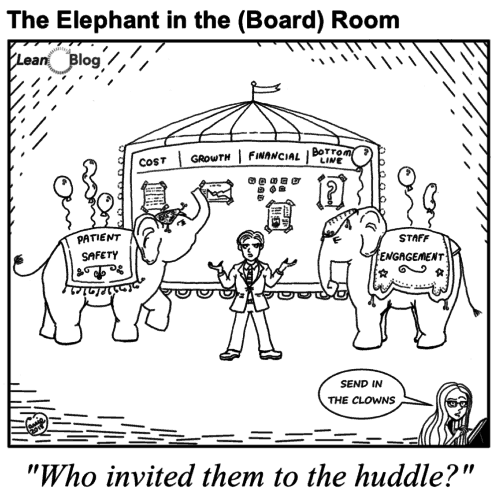Today's post is my eighth cartoon collaboration with a skilled artist and medical assistant, Carrie Schurman (see past cartoons). You can find her on Twitter as @carrieschurman.
Our most recent cartoon was a parody of the editorial cartoons from “The Onion” and Carrie drew this one in a similar style (yes, it's a parody of a parody).
Here is our latest creation with some commentary to follow (click for a larger view):
The, ahem, “balanced scorecard” that you see there reads:
- Cost
- Growth
- Financial
- Bottom Line
That's not a good example of “True North.” It might be accurate for a given organization, but it would be better to see something like Safety-Quality-Delivery-Cost-Morale.
The “elephants in the room” are, of course, patient safety and staff engagement. Those arguably should be part of your strategy deployment “true north” goals.
Is “patient safety always our top priority?” Easier said than done.
See these past blog posts:
“Safety is always our top priority” – From lip service to daily practice?
A Story About a Hospital Putting Safety First Over Patient Satisfaction
Thoughts on the cartoon?
Please scroll down (or click) to post a comment. Connect with me on LinkedIn.
Let’s work together to build a culture of continuous improvement and psychological safety. If you're a leader looking to create lasting change—not just projects—I help organizations:
- Engage people at all levels in sustainable improvement
- Shift from fear of mistakes to learning from them
- Apply Lean thinking in practical, people-centered ways
Interested in coaching or a keynote talk? Let’s start a conversation.










![When Was the Last Time a Leader Around You Admitted They Were Wrong? [Poll]](https://www.leanblog.org/wp-content/uploads/2025/07/Lean-Blog-Post-Cover-Image-2025-07-01T212509.843-100x75.jpg)
That’s a good cartoon, Mark. Heh. I wonder if any executives or company leaders ever see your cartoons. Do you know of anyone? If so, what type of feedback have you gotten from them?
I guess the cartoons aren’t designed to necessarily influence executives. They probably aren’t consuming the cartoons. And the tone is a bit mocking, so I’d admit that’s not a great strategy for effective change.
The cartoons make me chuckle. It’s more likely to reach frustrated internal Lean facilitators or process improvement people in an organization. Those are the folks who tend to print these out and hang them on the wall.
It’s like a Dilbert cartoon. I don’t see many bosses or executives with a Dilbert cartoon on their door or wall. It’s the “worker bees” in cubicles who tend to post Dilbert cartoons or have the daily calendar on their desk.
I’ve thought of that as a morale metric – the number of Dilbert cartoons that are posted. Of course, if management bans the posting of Dilbert cartoons (“they hurt morale!”) then they aren’t looking for the real root causes of bad morale. The posting of those cartoons would be a symptom of poor morale, I think.